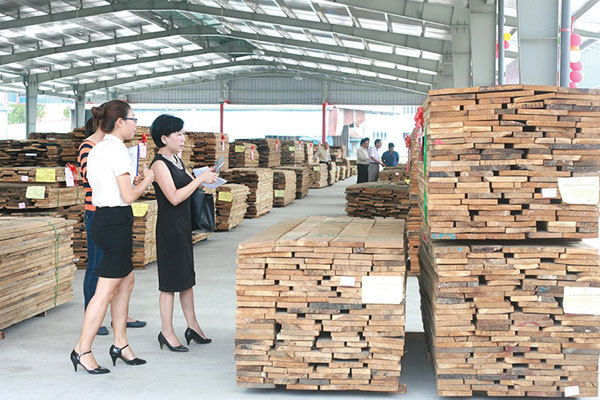To strengthen cooperation between these and domestic companies, the adoption of new policies seeks agreement among experts and other stakeholders.
 |
|
To foster a successful timber export industry, experts advise a strong cooperation between FIEs and domestic businesses.
|
Kuka Home, a fully Chinese-invested company has started construction of a wood-furniture processing factory after only six months of signing a lease contract for more than 12 hectares of land in Dong Xoai Industrial Park III in the southern province of Binh Phuoc. According to Li Binh, in charge of the factory’s construction, the company has invested in a system of factories in industrial zones in many provinces of Vietnam, including in the southern province of Dong Nai, to produce wood for export.
Exports of foreign-invested enterprises (FIEs) last year continued to show their superiority over domestic ones. By the end of 2020, Vietnam had more than 3,600 enterprises directly involved in exporting timber products, with an export value of $12.31 billion in 2020.
Among these, 653 FIEs account for 18 per cent of the total number of export enterprises. The export value of these companies reached $6.07 billion, accounting for 51 per cent of the total export value from timber products.
No competitive position
FIEs continue to play an important role in Vietnam’s timber and wood product exports as more of them invest in the industry, thus becoming an important component of Vietnam’s exports from this sector. Last year, the export turnover of the entire wood industry increased by 16.2 per cent compared to 2019.
The export value of these FIEs is especially high in southern localities like Binh Duong, Dong Nai, and Ho Chi Minh City. Binh Duong is the leading province in terms of last year’s export value in the wood industry, reaching $5.68 billion and accounting for 47 per cent of the total export value of the country.
In which, FIEs reached $3.85 billion, accounting for 68 per cent. Meanwhile, domestic businesses only raked in $1.8 billion, holding 32 per cent. Dong Nai ranked second and hit $1.62 billion, or 13 per cent of the total.
The increase of FIEs participation in the wood industry is a direct result of preferential policies and investment attraction measures by the government and partly the result of new-generation free trade agreements, as well as the favourable geographical position of the Asia-Pacific economic region. The tensions within US-China trade also created opportunities for Vietnam to receive capital flows from China in this industry.
The export growth of Chinese wood processors also shows that the financial scale and production capacity of FIEs are far ahead of domestic players.
“Capital and production capacity are both important factors that drive growth for FIEs in the wood processing industry,” said Nguyen Liem, general director of wood product exporter Lam Viet JSC.
For instance, investments of $5 million are huge for Vietnamese companies, but $10 million, or even $15 million, are still small for an FIE.
“A contract for 100 containers will be produced in 15 days,” explained Liem when talking about the production capacity of Chinese players.
“They carry out all operations very quickly, install equipment, and import raw materials before they produce around the clock,” he added.
According to Liem, Chinese enterprises investing in Vietnam’s wood processing sector are mostly manufacturers with decades of experience, who produce goods of medium quality but in large quantities for export.
Compared to FIEs, Vietnamese businesses are “not in a competitive position,” said Liem, who has worked more than 10 years at an FIE within the industry.
Before Chinese wood manufacturers were investing in Vietnam, US buyers already knew them. As the US-China trade war broke out, many Chinese wood processors invested in Vietnam to open factories. They dragged American buyers to their new location and signed large quantity contracts. Even the leaders of some large corporations in the US noted that their representative offices in Vietnam are now often bought by from Chinese-owned companies.
One unified system
The wood industry is witnessing a common phenomenon: the more developed, the higher the risks. Currently, Vietnam ranks second in Asia in the export of wood and timber products, with a rapid growth rate of about 17 per cent per year.
Businesses exporting wood products to the US market are under pressure from an investigation by the United States Trade Representative (USTR) regarding allegations of using illegally harvested or traded timber.
The Vietnamese government is trying to create an open policy mechanism to attract investment. But on the other hand, the government is also trying to control under- and shadow investments.
Tran Le Huy, vice chairman of the Forest Products Association of the central province of Binh Dinh, noticed that the wood industry is “lacking an appropriate mechanism to spread the strengths of FIEs. Meanwhile, the spillover effect only occurs when there is a suitable mechanism allowing domestic businesses and FIEs to exchange information and experiences.
Huy believed that allowing FIEs to be official members of wood associations will create a unified system between both sides. “This will contribute to better positioning and mitigating risks in foreign investment activities, while at the same time, building a sustainable Vietnamese wood industry in the future and helping to bring domestic players closer to the market,” Huy explained.
However, in the middle of the pandemic, the business environment of Vietnam remains highly appreciated by foreign investors. Vu Tien Loc, chairman of the Vietnam Chamber of Commerce and Industry, said that Vietnam has become the first choice for FIEs in the region, with 136 economies investing in the country with the total investment capital of over $400 billion.
According to Loc, with over 70 per cent of Vietnam’s export value coming from FIEs, these enterprises are also the main driver of export growth, bringing Vietnamese-made goods into global supply chains.
“If local and overseas companies are not symbiotically linked, it will be difficult to bring pervasive value,” Loc said, adding that the government should create a symbiotic environment between foreign and Vietnamese enterprises, and must encourage domestic ones to participate in the supply chain besides FIEs.
At this point, there are basic conditions to connect FIEs with their domestic counterparts effectively. The country’s Strategy for Socioeconomic Development 2021-2030 stated that foreign direct investment will continue playing an important role in national development.
The total registered capital within the 2011-2020 period reached over $278 billion, an average increase of nearly 6.9 per cent per year, accounting for 22.8 per cent of the total social investment capital.
Therefore, “the economy backed by foreign investment capital develops rapidly,” according to the strategy’s report. Meanwhile, the 10-year socioeconomic development strategy and the 5-year plan emphasise the strengthening of the links between FIEs – especially multinational corporations – with local suppliers.
|
Ha Cong Tuan - Deputy Minister of Agriculture and Rural Development During the investigation under the US Trade Act about the alleged use of illegally harvested and traded timber, a representative of the USTR consulted the Vietnamese government and opened hearings to gather opinions of both parties. Most said that the US accusations were not satisfactory. Therefore, the US has not yet made any official conclusions. The issue, however, could become a big story of the trade relationship between the two countries, which could force Vietnam to find a suitable solution to ensure more balanced trade. The state’s role is especially important in providing solutions to problems with the US market. Meanwhile, those who are exporting to the US need to comply with the laws in this market. Trade relations in a market economy must be two-way. Therefore, there are things that must sacrifice certain interests to receive certain goods of the partner country as a trade-off for a suitable and balanced trade relationship. |
VIR

Strategic market identification sought for stronger wood trade
Vietnam’s wood industry is leaving behind a successful 2020, ready to embrace the new advantages that some of last year’s signed and effective trade agreements bring with them.

Vietnam wood industry regains growth momentum
Despite a tough year due to the COVID-19 pandemic, the national wood sector looks set to achieve its export turnover target of US$12 billion,